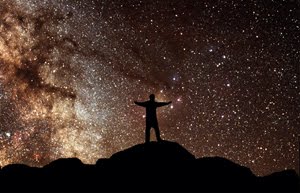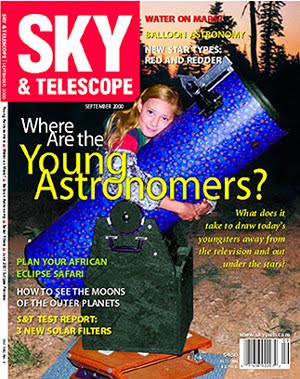Last night a small group of bay area observers trekked down to Bob Ayers' Willow Springs property south of Hollister. The drive was uneventful, other than noticing hazy conditions in Panoche Valley, and from the flat on the property overlooking the valley to the south.
Ayers's property is a special place, one which I sincerely hope it continues to be available, and that he and the SJAA find a path to that end. While the transparency and darkness were noticeably off compared to prior trips there, it was still impressive. A hands down winner compared to the other bay area choices. Imagine... elevation... no street lights, house lights anywhere (well, one maybe five miles away, but it went out by 10 pm)... no car lights... and nothing but the sounds of nature, Servo-Cats, and observers chatter. It has it all.
The first target was Comet Swan. I viewed it in an 18" Plettstone, 16" NightSky, and 80mm William Optics. Nice views. Although not in the class with the big "we're spoiled by them" comets of the 90's, this one is bright, effectively naked eye at about mag 6, and last night well placed next to a naked eye star over the ridge to our northwest. The nucleus is very distinct, and the coma large, appearing like a good size globular cluster in a small scope (unresloved). There were hints of elongation, leading to discussions about tail or no tail.
I started in right away on a list saved in an Excel on my laptop. That and Megastar were my tools, along with an 18" f/4.5 Obsession Dobsonian, 20mm, 12mm and 7mm Naglers, 10x70 optical finder and Rigel Quickfinder. I am acclimating nicely to Megastar after using The Sky until two months ago. I'm also toying with the idea of moving toward hard core ascetic astronomy... unloading unnecessary aspects of the hobby and making it as unencumbered a hobby aspossible...but still maintaining the ability to knock off mag 16 anonymous galaxies.
I began by tracking down the NGC 128 group, star hopping from mag 4.3 Epsilon Psc to mag 4.2 Delta Psc to mag 5.7 51 Psc to mag 5.8 44 Psc. Under good conditions, there are more than half a dozen galaxies in a 171X field, using my 12mm eyepiece.128 and NGC 130 comprise the two brightest members. 128 is extended nne/ssw, is bright, thick and long, with a bright almost stellar core surrounded by an oval brightning terminating in thin extensions. NGC 130 is faint and elongated n/s, very nearby 128, both visible together at 283x in my 7mm. NGC 127 is very faint, to the NW of and perpendicular to 130. NGC 125 is a dim halo around an obvious stellar core, elongated slightly NE/SW with two stars close by to SW. NGC 126 is small, dim elong WWNW/EESE with dim stellar core and possible dim star involved. This is a fun group visually, and well worth the trip.
I joined one of the other observers hunting down Palomar 12 in extreme eastern Capricornus, off of Kappa and Epsilon. This is an easy find at 103x as faint glow off double star. With magnification the Double becomes a triple to the object's south. Pal 12 appears at 293x as faint glow, like dim nebula, overlayed with several brighter stars.
With good early success on the first two targets, I went after Hickson 99. But first, one of the other observers present was so taken by his first view of a Hickson (#16), he went on a Hick-Binge. We were laughing, how easy they were and thinking about a friend in Roseville who ran through nearly the entire Hickson catalog (over a year or two?) ... remarking what a challenge they were. My observing friend nailed 15 or more last night, in a smaller scope than the Roseville observer used. I suppose it is a testament to the skies as Willow Springs.
Hickson 99. In an easy star hop location, this was a nice site. Start by putting Alpha And (Apharatz) at the edge of your finder such that a distinct chain of six stars arcs to the south and west also along the edge of the finder. A bright star will be nearly centered in the finder as the vertex of an equilateral triangle with its base to the east. Use those three stars to hop in your eyepiece. The galaxies in Hickson 99 are UGCs 12897 and 12899, along with dimmer CGCG 498-61. My view of the UGCs showed them at right angles to each other, both elongated. However, I could not locate the CGCG. Turns out UGC 12899 is round, and the CGCG is so close on its west that the two appear as one, elongated E/W. Notice also how UGC 12897 is abutting a mag 11.6 star on its southern edge, which helps differentiate it from the "other" galaxy.
Next was a galaxy cluster, Abell 119 in Cetus. This too is a very easy hop, looking at Diphda (Beta Ceti), and drawing a line exactly between Eta and Iota Ceti almost due north to mag 4.7 20 Ceti. Place that star just off center to the west in the finder you'll first notice NGCs 133 and 144. You can almost lose your mind, in a fun way, hunting galaxies in this cluster. Here, with abbreviated catalog numbers, are the 40 galaxies I logged before deciding to move on. mac 0055-0114A, 0015, CGCG 384-28, mac055-021, 0125, 0130, 0117, 0118D, 0109, cgcg 384-34, ngc 307, mac 056-0137a, 0136, 0135, 0123A, 0115C, 0118, 0113B, 0114B, 0116A, 0116B, 0110, cgcg384-37, cgcg384-32, cgcg384-36, ugc 579, ugc 583, cgcg 384-35, mac 056-106, 0109, ugc 587, cgcg384-40, -42, mac 057-0117, 0122A, 0123, 0120, 0118, 0120A, ugc 595.
One mistake I made with my observing list was to not include object's common names. Otherwise, I would have known IC 5146 is the Coccoon Nebula (I suspected it was), and would have followed the nice dark nebula Barnard 168, which is a treat. The dark nebula is long and thin, easy to find, and terminates on one end in a nub that contains the Coccoon. By not knowing I was after the Caccoon, I went through an extensive contortion of star hops starting in Cepheus. When I arrived at the Caccoon, I was shocked at how bright it looked. I called over a number of other observers, who referred to it as "subtle". Well, I thought it was bright - but upon looking at it again, it was dim. With an H-Beta filter and 12mm I felt the dark lanes in the Coccoon. The original view without filter in 20 Nagler was best.
Again in Capricornus is the great galaxy NGC 7184. Large and elongated EENE/WWSW, its very bright core seems skewed from extensions. The Core itself is very bright. In the same 180X field NGC 7180 is smaller to the south and elongated same directions. NGC 7185 easy too, roundish. I had difficulty finding this group, as it was low in the west.
Next was Abell 539 is a rich cluster in another easy location. Place a finder with its eastern edge on Bellatrix. There are several distinctive patterns in the finder that will allow centering on the AGC field. There must be 30 galaxies in a 20 Nagler field. We logged UGC 3274 and the combined MAC 0516+0626C and 0626B. These three galaxies appeared at two. Close by to their north were four other galaxies. I'll let one of the other observers detail this group, but we must have picked out a dozen galaxies hopping around the UGC at high power.
It was getting late, but we moved on to the NGC 1016 group nearby M77 in Cetus. In this group we observed NGCs 1016, 1008, 1004, 993, 1019, 1020, 1021, 1009, ic241 and cgcg 388-80. This was a fun group to hop around in. It is really amazing what can be seen.
Gemini was now up high, and I could see what appeared to be the zodiacal light in the east, well off the Milky Way which now appeared to run from just east of south, up to the north. In Gemini, it was an easy hop off mag 3.6 Theta Gemini. This group of five galaxies form a nice arc, reminiscent in shape of Corona Borealis. The group is comprised of NGCs 2294, 2291, 2289, 2288 and 2290.
It was an amazing night of observing, but not even the best night I've seen at Willow Springs. We turned in close to four a.m I'm guessing. I awoke to a beautiful blue sky, and three vehicles pulling out. I got up and relaxed having coffee with a new member of the group - learning about the individual's background in artificial intelligence, expert systems, years studying Sanscrit and the time he spent in living in a house boat in Kashmir. The last member of our party awoke, I said a quick good morning, then good bye, and headed out. An hour and forty minutes was I home. Can't beat that!
Clear skies, and thanks Bob!











